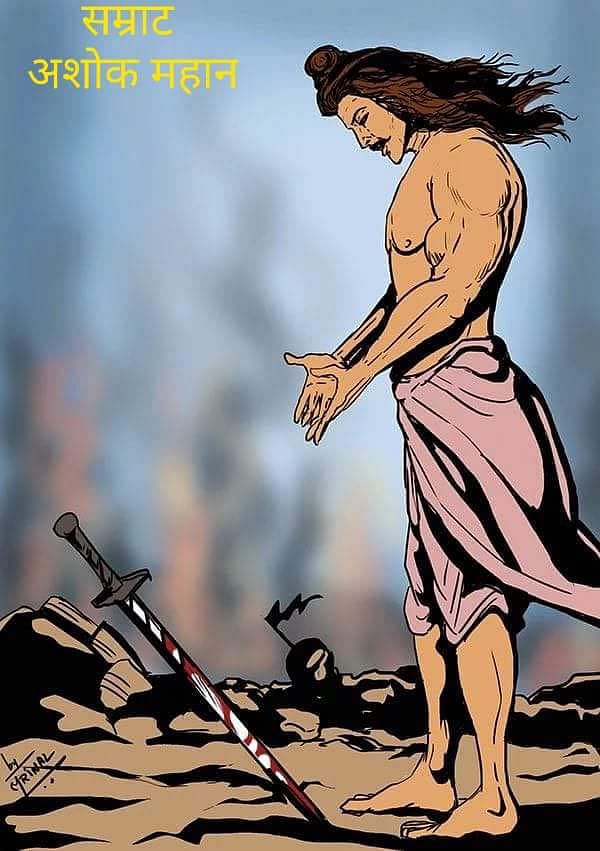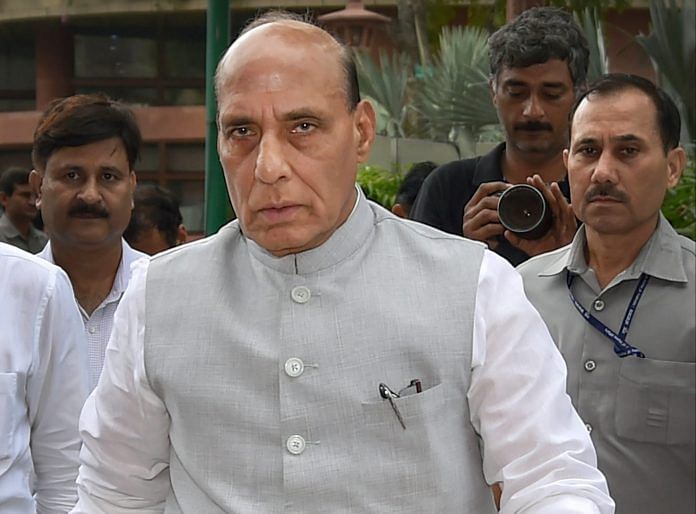Speaking in the Lok Sabha against the no-confidence motion on 20 July, home minister Rajnath Singh hailed the historic roots of democracy in India. As part of his speech, he invoked Chandragupta Maurya, the founder of the Mauryan Empire (321-297 BCE).
His comment has upset Maurya and other caste groups in different states across north India. Demands are being made for his resignation, and his effigies have been burnt.
The ‘objectionable’ part has been singled out for attention on YouTube and elsewhere. Singh says, “Earlier, only those from Rajvansh (ruling dynasties) would become king. But the first time someone who was not from a Rajvansh became king, it was Chandragupta Maurya. And (he) was not a high caste individual (sic).”
“From Afghanistan to Burma, he had an extensive empire. He had acquired power through the path shown by a vaidik Brahmin, Chankaya, but his coronation took place as per Jain traditions. In his last days, he gave up his throne and went to Karnataka and became a sanyasi…”
“Chandragupta Maurya was a man who used to graze cattle in the village. Democracy is ingrained in Indian roots and traditions. That’s how a cattle grazer like Chandragupta Maurya became the king of the country. This is also why a tea-seller became India’s Prime Minister.”
https://youtu.be/EoX6JPNGWb4
A peasant OBC community, Kushwaha, has not taken kindly to the home minister’s words on the 4thcentury BC ruler. Kushwahas, particularly from Rajnath’s home state Uttar Pradesh, are upset that he ‘insulted’ Chandragupta Maurya.
Other OBC communities such as Shakya, Saini and Mauryas are also upset. They are all agriculturist castes. Sainis are also known as Malis because their caste profession is gardening. Mauryas are also known as Murao, and the community is traditionally involved in growing vegetables. Kushwahas are also known as Koeris, and are traditionally agriculturists, as are Shakyas.
Don’t call us shepherds
Rajnath only said what these communities also claim: that Chandragupta Maurya established a vast empire, he came from a humble background, and not from a high caste. What’s so offensive?
What’s offensive to them is the profession — Rajnath said Chandragupta Maurya was a cattle grazer, which, according to some people, is ‘lower’ in caste hierarchy than those who grow vegetables and cash crops. Rajnath effectively called Chandragupta Maurya a Gadariya.
The protesters are not clearly spelling this out because they don’t want to be seen as insulting Gadariyas either. They have just been saying that the home minister has insulted Chandragupta Maurya by indicating that he belongs to “neech jaati” – although he did no such thing.
These peasant communities are well-off as compared to Gadariyas, who are generally poor. They often own some land and have been politically assertive in recent years. Kushwahas, Shakyas, Sainis and Mauryas are similar in their social and political status, and are thus finding common ground with each other. Particularly in Bihar, they have benefited from the reservation policies of Nitish Kumar, who targeted such communities politically.
These are just the sort of caste communities who used to be divided between different parties in states like UP and Bihar, but have now been consolidated behind Brand Modi. They are the bull’s eye of the Modi-Shah caste strategy.
With the Modi-era BJP giving these communities importance, they have become more assertive. The rising social and economic status has helped these communities to mobilise – the protests are a result of this.
The BJP has been at the forefront of the project that involves making Chandragupta Maurya a Kushwaha icon. Before the Bihar elections in 2015, the party had launched a campaign hailing Chandragupta Maurya as a Kushwaha.
This is only one example of how the BJP has wooed the OBC communities who are below the dominant OBC castes, such as Yadavs, in the caste hierarchy. One of the BJP’s alliance partners in the National Democratic Alliance is the Rashtriya Lok Samta Party, which is led by Upendra Kushwaha. He is a minister of state for human resource development in the Modi government.
Incidentally, there’s no evidence to suggest that Chandragupta Maurya was a Kushwaha, or what his caste was at all. At best, it is believed he may have been from a ‘lower’ caste.
But facts never came in the way of caste assertion in politics.
Protests from Jharkhand to Gujarat
The protests may be organised by small caste associations, but what is interesting is that they are spread across states. There have been effigy burnings, candlelight vigils and demands for Rajnath’s resignation. Many of these have been organised by one particular organisation, the Akhil Bhartiya Maurya Mahasabha.
In Patna, the Mauryavanshi Yuva Sena burnt an effigy of the home minister.
There have been protests in almost all districts of Uttar Pradesh, including Unnao, Bareilly, Ambedkar Nagar, Jaunpur, Amethi, Azamgarh, Hardoi, Ghaziabad, Allahabad and Lucknow.
A Congress spokesperson in UP has called Rajnath’s statement a reflection of the RSS school of thought, as has a Kushwaha leader of the Samajwadi Party. A Maurya group organised a protest in Faridabad, Haryana. There have been protests in Hussainabad and Jamshedpur in Jharkhand.
A protest was also organised in Mainpuri, UP.
संसद में गृहमंत्री राजनाथ सिंह द्वारा चंद्रगुप्त मौर्य पर की गई टिप्पणी के विरोध में शाक्य कुशवाहा मौर्य सैनी समाज के सैकड़ों लोगों ने राजनाथ सिंह को मंत्री पद से बर्खास्त किए जाने की मांग की और राजनाथ सिंह मुर्दाबाद के नारे लगाए pic.twitter.com/UMrTclN6QN
— JP Shakya Patrakar Amar Ujala (@jp_shakya) July 26, 2018
Even in Ahmedabad someone is upset.
महान चक्रवर्ती सम्राट चन्द्रगुप्त मौर्य के विरुद्ध अपमानजनक टिप्पणी करने वाले भाजपा शासित भारत की केन्द्र सरकार में गृहमंत्री राजनाथ सिंह के खिलाफ एक कार्यक्रम का आयोजन अहमदाबाद, गुजरात में दिनांक – 29/07/2018, रविवार को सुबह 11 बजे किया जाएगा।
आयोजक :- pic.twitter.com/qjucx8COZb— Rajesh Maurya (@mauryarajesh23) July 27, 2018
The politics of caste
Meanwhile, here’s what Chandragupta Maurya looks like in a UP-based WhatsApp group of the Maurya community.

It is possible that such coordinated protests in different states have been fuelled by a rival of Rajnath. Or, maybe they’ve just been coordinated through that wildfire called WhatsApp. But it would be a mistake to read them merely in the context of the Lok Sabha elections next year.
This bizarre story is a slice of the daily life of caste politics. This is how caste groups assert themselves politically, seek greater self-esteem in society and greater access to power.
It may be easy to ridicule people trying to make Chandragupta Maurya their icon. It may seem bizarre that people are spending so much time asserting just how ‘low’ or high the caste of a 4th century BC king was, but that’s what a caste society is. This is about politics, yes, but this is also about caste. This is who we are.




Kyaa journalism saalaa tumhara maali jaati alag jaati hai Saini nhi hai woh unsey humara koi relation nhi iddhar jiddhar jiddhar Saini likha hai usko maali likho…humari caste ko Matt laao beech mein aur insey aur jo bi jaatein hai humara social status bohatt high hai humko Matt jodo inmein
this is all bull shit,great chandragupt maurya and ashoka as well was a suryavanshi kshatriya which was mentioned in all the documents written in many books of buddhism. rajnath singh is opposing caste belonging to him only.
Those, who does not respect The great Ashoka Maurya, either proves to be not Indian or they believed to be Indian Chamar. The signature is being royal emblem of India which is embedded on Indian currency as well in every head gear of yodhas. Hence here after stop all. Those are bastard who opposes Mauryans to be royal.
Thanks,
It is all irrelevant things to discuss now. The old history never looked down any people on their profession. Actually the society was never divided on the caste basis but it is clearly a functional orientation. Switching over from one Varna to another is not a taboo. Thus, the discussion that Maurya belonged to a particular caste is rubbish and may give a second run to the castiest evil Lalu .Better stop it.
Oh..! You are making a lot of sense! And that’s the biggest problem in India. Now the mystery as to how the kushwahas or the sainis or the whatnots came to the conclusion that Chandragupta or Ashoka are their caste forefathers is second it to that of the exact property properties of a black hole! How pathetic!!
Some people are only searching for wrong thing in right perspective to become leaders in the name of caste or religion. Rajnath Singh is one of the highly respectable honest and intelligent leader of the time. So instead of understanding his perspective some morons are creating wrong media hype and unnecessary problem in the country. Mauryas are always integral part of Hindu Religion peaceful and respectable people. Some selfish anti BJP persons are demonstrating their political desires by misinterpreting the statement
The present day surnames may not be continuity of past. When history was not documented just to get some political milage ,it is not good to attribute castism. Why BJP go on hammering on caste and religious polarisation. Persons occupying high seat can t they resist from being mediocres. You talk of OBC . It is after all classification done by govt for particular purpose
There are some castes classified ad upper castes in some states and the same is classified as OBC in some other states and the same caste is classified as scheduled caste in some states. No body knows how this transformation has taken place
Don’t be nonsensical in approach.
Mahapadmananda was the first emperor of magadh and he was a barber. However he became the emperor by unfair means.